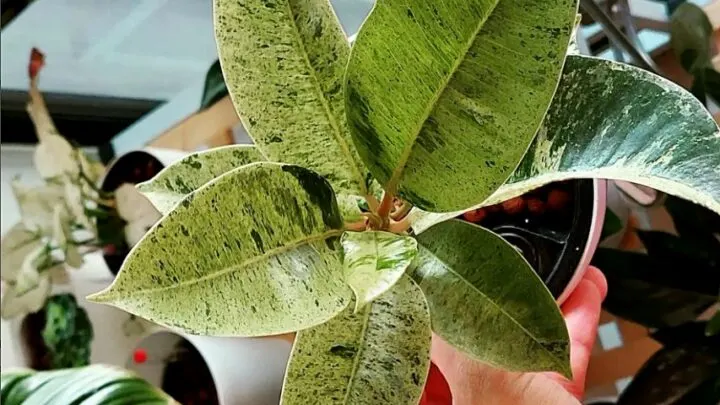Ficus Shivereana ‘Moonshine’ care. The Ficus moonshine variegata shivereana can be placed anywhere but is usually best if kept near a window.
It has lime-green leaves with spots on them that add a fresh look to the plant and the space where it is placed.
It is considered an indoor plant that requires frequent watering.
Ficus Shivereana Mooonshine Care
Ficus Shivereana grows best in moderate to warm temperatures ranging from 59 to 77 degrees Fahrenheit (15-25 degrees Celsius) and needs well-drained soil with liquid fertilizers (occasionally). It needs bright, indirect sunlight evenly distributed to the whole plant and a humidity of 50% or more.
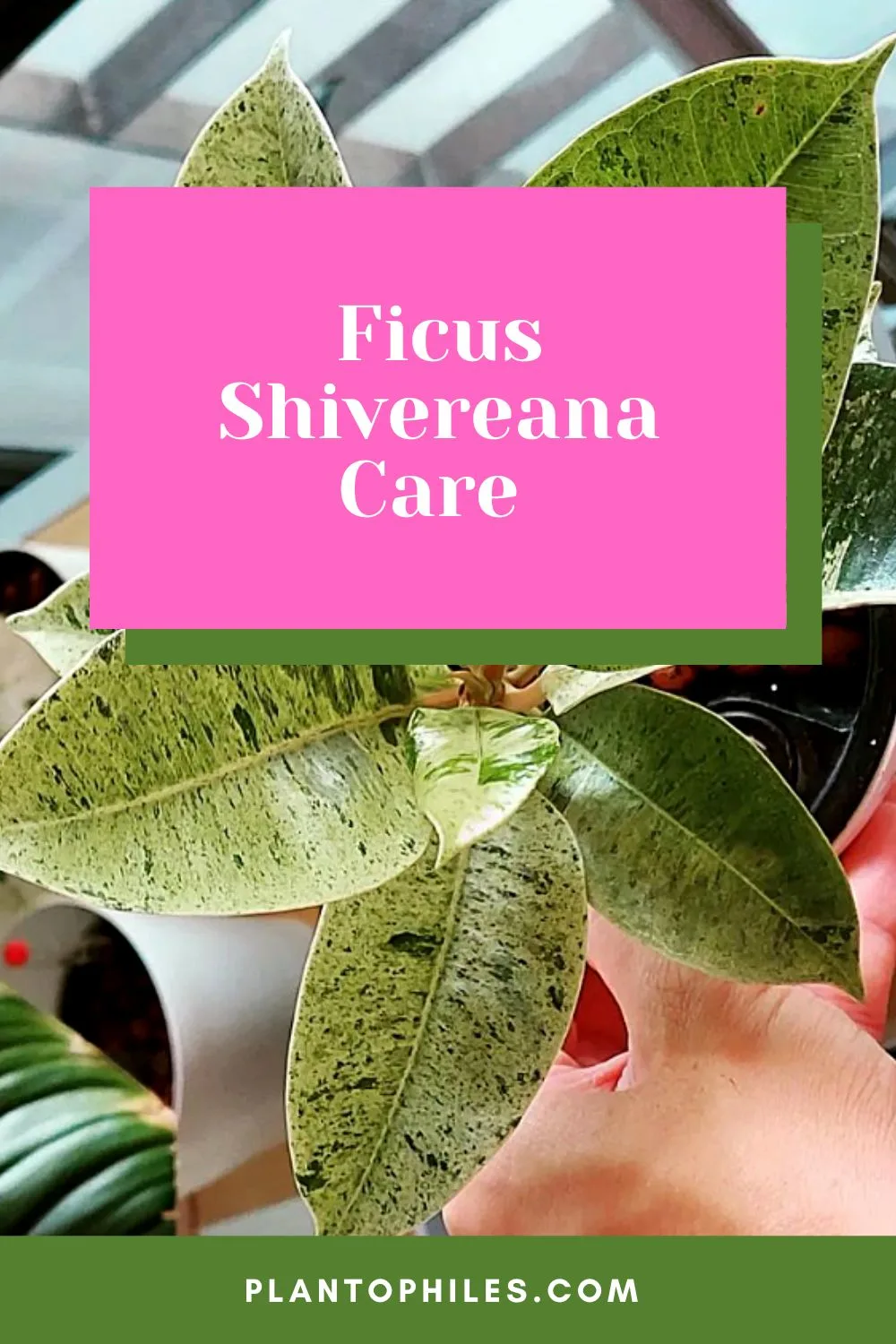
Table of Contents
Ficus elastica shivereana
Ficus Shivereana is rare. it is a hybrid form of ‘Ficus elastica.’ It is a rubber plant with thick, fleshy leaves.
It requires some time to settle in a new location, so it is best not to overcrowd it immediately after getting it.
The plant needs proper care and abundant watering and sunlight to thrive. Negligence towards the plant can reduce the quality and vibrance of its leaves.
It has thick stems and grows up to 2 meters indoors if given optimal growing conditions.
The fresh color of the plant increases the beauty or aesthetics of any space it is placed in and gives an overall new look to the room.
It can also be planted outdoors, but certain environmental conditions should be monitored to ensure its well-being.
The plant’s roots can overgrow, so it is best to confine them to a pot.
All the care guidelines for this beautiful, rare houseplant are listed below so you can grow a beautiful and fresh Ficus Shivereana.
Ficus Shivereana Care Guide
Soil
The soil used for planting shivereana rubber tree should be moist but not too wet. It should be well-drained and fertile to ensure proper growth.
It should be kept in mind that the soil should have enough nutrients, and the plant should be transferred to a different pot when the nutrients fall short.
Due to its high organic content, loam soil is considered best for Ficus Shivereana.
The pH of the soil should be maintained between 6.0 and 6.5. more acidic pH leads to reduced growth of the plant.
Water
Ficus Shivereana thrives on water, and providing it with just the right amount of water is essential.
Overwatering or underwatering can damage the plant. Hence, it should be watered according to the weather or soil conditions.
For example, if the plant is not receiving direct sunlight due to cold weather, it needs 0.8 – 0.9 cups of water every 9 days in a 5.0” sized pot.
Watering should be reduced in the winter and kept moist during the summer.
It is ideal to allow its soil to dry out completely before continuing with another watering session.
Light
Sunlight directly affects the color and quality of the leaves of Ficus Shivereana.
The plant needs bright sunlight to thrive. Although it can tolerate low lighting conditions, deficiency of optimal sunlight can cause the leaves to fall and discoloration.
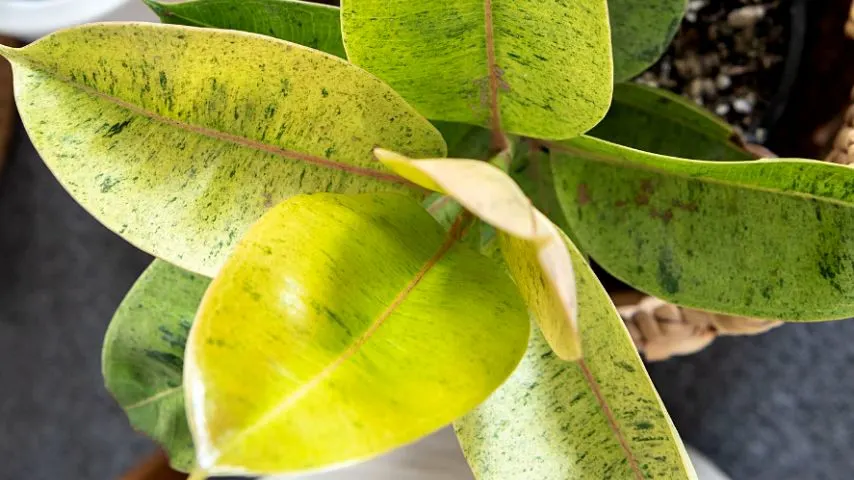
Hence, it is ideal for placing it near a south-facing window to ensure maximum sunlight throughout the day.
Temperature
The ideal temperature is between 15°C-25°C (59°F-77°F). It mostly thrives between cool to warm temperatures.
The plant can tolerate minor fluctuations in temperature, but it is best to place it according to the temperature in your location.
In winter, a temperature of 16°C-18°C (60.8°F – 64.4°F) must be maintained.
Humidity
The ideal humidity for Ficus Shivereana is around 50%, but it can also tolerate lesser humidity.
In extreme conditions, I would suggest a humidifier to avoid damage to the plant.
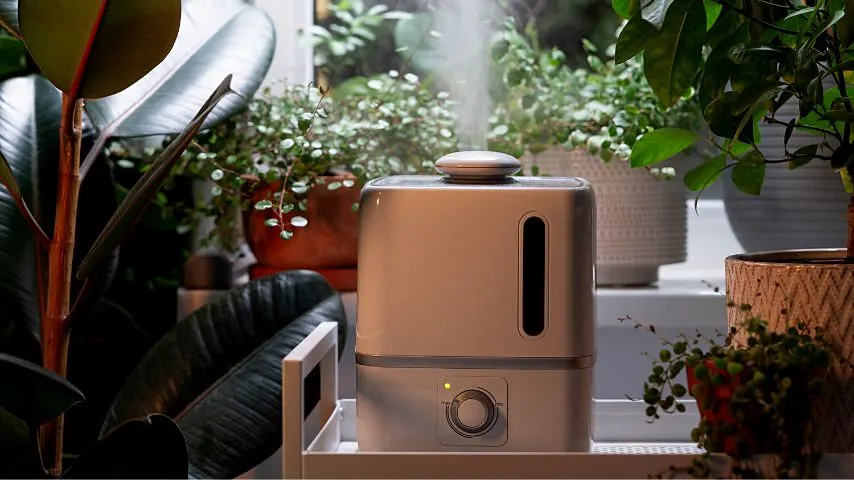
Fertilizer
The best fertilizers for Ficus Shivereana are liquid fertilizers.
The plant can do well without fertilizer, but mild fertilizers can help enhance its growth.
Usually, the potting soil has enough nutrients for the plant to grow, but when the nutrients have been reduced, the plant has grown enough to be transferred to a larger pot.
The use of organic fertilizer is recommended every 2 -3 weeks during the summer and spring seasons.
Recommended products are Perlite and Vermiculite, which are readily available on eBay.
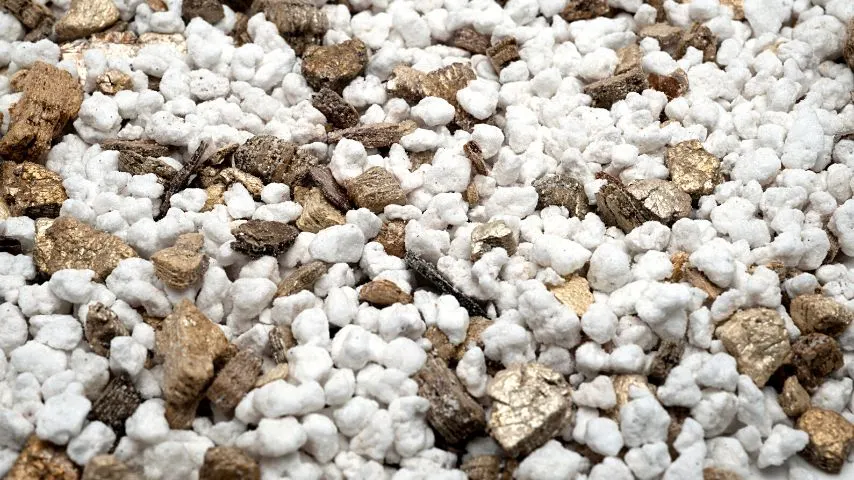
Balanced fertilizers should be used, but if you are repotting every year, the plant will do fine without any fertilizers.
Repotting
Ficus Shivereana is repotted yearly, usually in Spring, because it is the start of its growing seasons and needs fresh nutrients.
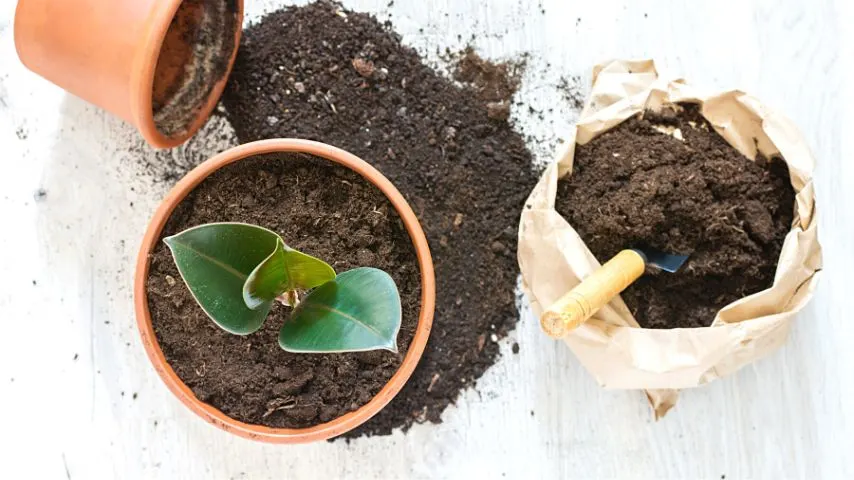
The steps for repotting are as follows.
- The pot to be used must have holes for drainage.
- For extra drainage, fill the pot’s base with expanded clay pebbles. They also help protect the roots from excess water.
- A mixture of Vermiculite, Perlite, and compost should be filled in the rest of the pot.
- Ensure that the soil is not compressed and there is room for oxygen because the roots need oxygen to grow.
- Avoid water-logging by letting the soil dry out completely.
Pruning
Pruning is usually done when the plant has grown to its full potential. You can trim the leaves to refine or shape them depending on what environment it grows in.
Prune your Ficus Shivereana during Spring or summer, their growing season.
But keep in mind that too much pruning can affect their growth rate. Hence it should be avoided.
Propagation
The propagation of Ficus Shivereana can be difficult if not done properly. It may take a few tries before your goal can be achieved.
Take the following steps for the propagation of Ficus Shivereana.
- It is best to plant it with Sphagnum Moss because it helps provide moisture to the soil and oxygen to the roots. It leads to decreased possibility of root rot.
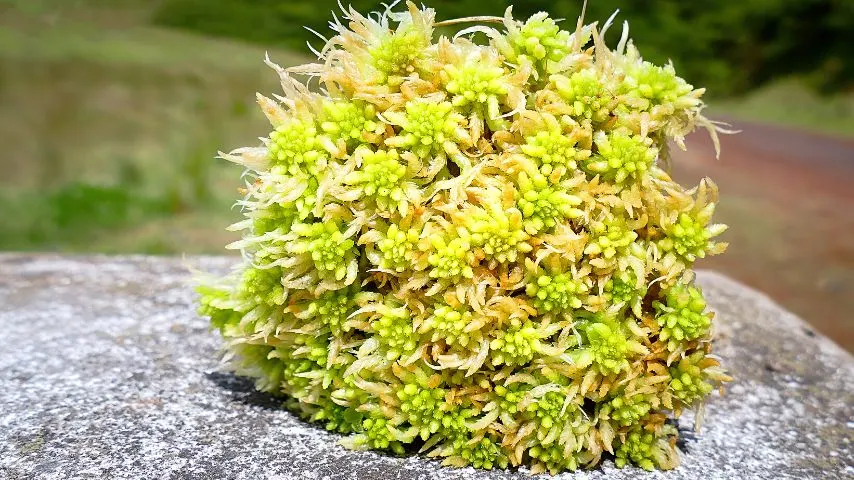
- A transparent container is preferred so you can see how much the root has grown over time.
- A cutting of Ficus Shivereana should be dried first and then placed in the moist sphagnum moss.
- The potting soil should contain a rooting hormone to help assist in root growth.
- It should be placed in a plastic bag afterward to increase humidity and placed in indirect sunlight.
- The temperature should be maintained at 21 – 24°C for optimal results.
Blooms
Ficus Shivereana rarely flowers indoors.
Growth – Ficus shivereana size
Shivereana rubber plant can grow up to 6.6 feet (2 meters) indoors.
However, if planted outdoors, the plant can reach up to 66 feet (20 meters).
The plant grows approximately 24 inches per season (0.6m).
The leaf size depends on the amount of lighting provided to the plant. If there is a sunlight deficiency, the leaves are smaller than the plant grown in full sunlight.
It is ideal to rotate the plant every few weeks to ensure that the whole plant receives an equal amount of sun. This helps build an even shape of the plant.
View this post on Instagram
Ficus shivereana variegated Pests & Diseases
Overwatering
People make the common mistake of overwatering, especially in cold climates where frequent water is not required.
Although the plant needs water, you should let the soil dry before watering it.
Overwatering leads to discoloration in the leaves.
Usually, the oldest and biggest foliage at the plant base turns yellow or brown. This is a sign of overwatering.
Stop watering your Ficus Shivereana and wait for its soil to dry out if these symptoms appear entirely.
Leaf Burn
Ficus Shivereana needs a good amount of sunlight, but extreme and direct sunlight can be harmful.
Too much direct and blazing sunlight can cause leaf burns if not kept under check.
Leaf burns are severe to the extent that the plant can be killed.
Hence, placing the plant in indirect or filtered sunlight is recommended to avoid leaf burns.
Curling Leaves
If the leaves of your Ficus Shivereana are curling, it indicates that something is not being done properly.
Curling leaves can be due to many reasons, including low humidity, too much sunlight, pests, cold, or negligence in proper watering.
Overwatering is one reason for leaf curling because it causes root rot. Stop the root rot the soonest as you can if you want to save your Ficus Shivereana.
It can be due to a container with no drainage holes, soil that is not well-drained or simply too much watering.
Underwatering produces the same results as overwatering. Leaf curling can also happen if the plant is not receiving enough moisture.
As the pressure builds up on the leaves, they begin to curl.
Too much cold or frost is another cause of leaf curling. Ficus Shivereana is a plant for the tropical climate and loves warm conditions.
If the weather is too cold, it causes leaf curling. Hence, you should maintain a proper temperature indoors.
If the plant is outdoors, ensure the weather is frost-free or bring the plant inside in extreme cold.
Ficus Shivereana can not tolerate dry conditions, and a humidifier should be used to avoid lead curling.
Many indoor and outdoor pests damage the leaves.
These pests usually suck the juices from the leaves, causing them to curl up. Hence, it is important to use insecticidal soap to treat pests.
Dropping Leaves
The leaves of Ficus Shivereana do not grow back in the same spot once they fall. So, leaf falling should be avoided.
Some causes of a leaf falling are age, overwatering, and cold.
The age of the leaves cannot be controlled, but if the growth rate of new leaves is faster than the falling, then it should not be a problem.
Overwatering should again be controlled through proper well-draining soil and a pot with drainage holes.
Leaf Spot Disease
Leaf spot disease is an infection caused by parasitic algae, and the leaves show brown, gray, or orange spots on the leaves.
This condition is not fatal for the plant, but it requires attention. The discoloration can be in the center or at the edges of the leaves.
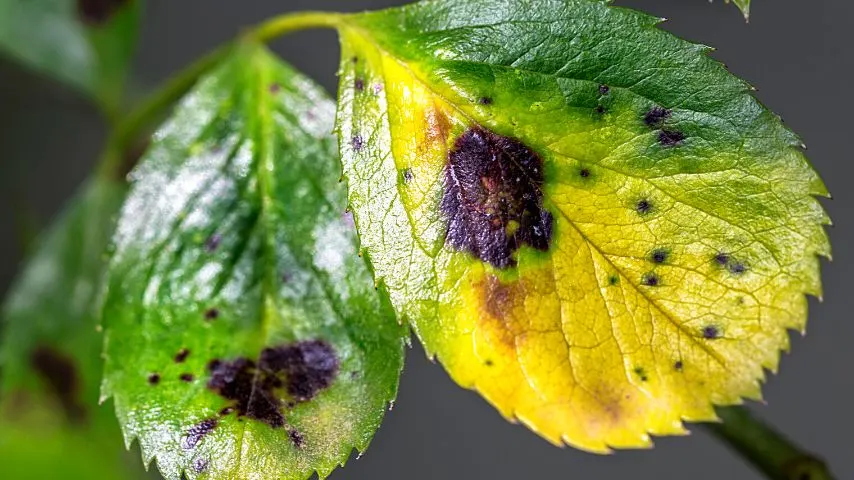
It causes slowed growth rate of the plant and premature falling leaves.
This condition can be controlled by pruning the dry and affected leaves to let the healthy leaves grow at their vest.
In case of severe infection, fungicides are recommended.
Tips for Growing Ficus Shivereana
- It is important to keep the plant hydrated, but too much water can cause waterlogging, root rot, discoloration, leaf falling, and curling.
- The plants should be repotted once it has reached maturity. The indications for repotting are roots growing through drainage holes, the plant being too heavy on the top, and the plant growing out of the soil.
- Liquid fertilizers are important for the root growth of new cuttings.
- Sunlight should be moderate. Not too high and not too low.
- Damaged and discolored leaves should be pruned.
Frequently Asked Questions
Why are my Ficus shivereana leaves small?
Ficus shivereana leaves need optimal sunlight. Lack of sun can affect the size of the leaves. It is important to place the plant where it receives enough sunlight to grow but not too much, which can cause leaf burn.
How to make my plant bushy?
Frequent pruning of the stems and proper sunlight is required to make the plant bushy. Cut above the nodes of the stems to have the best results.
When should I repot my Ficus Shivereana?
If the roots are growing through the drainage holes, it shows that you need a bigger pot for the plant. If the weight of the top of the plant is heavy and keeps falling over, it is another indication to repot. If the need for watering is frequent and the soil is drying out quickly, the roots have grown more than the pot’s capacity.
Are drainage holes necessary for the container?
Drainage holes are essential for the plant. Otherwise, the water-logging and root rot can cause the plant to die.
Why are my Ficus leaves turning yellow?
There are many reasons why the Ficus leaves turn yellow. One of them is age. The older the leaves get, there is the possibility that they might turn yellow or brown and fall off. Other reasons can be soggy soil, overwatering, and inappropriate sunlight.
Conclusion On Ficus Shivereana Care
To care for the rare Ficus shivereana ‘Moonshine,’ provide a temperature between 59-77°F (15-25°C), well-draining soil, bright indirect light, fertilizer once a month, and humidity around 50%.

Daniel has been a plant enthusiast for over 20 years. He owns hundreds of houseplants and prepares for the chili growing seasons yearly with great anticipation. His favorite plants are plant species in the Araceae family, such as Monstera, Philodendron, and Anthurium. He also loves gardening and is growing hot peppers, tomatoes, and many more vegetables.

